Ann Arbor Railroad
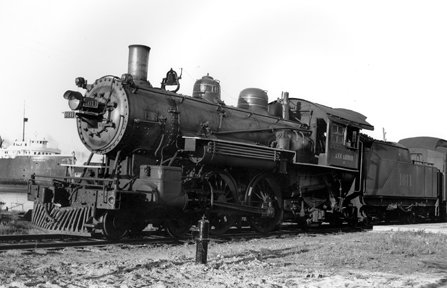 In the nineteenth century, railroads linked together town and countryside. People and goods moved with undreamed ease and speed. By the early twentieth century steel rails represented the nation's finest transportation technology. Competition, however,
from aircraft and trucks eroded the railroads' importance both as a means of transportation and as a symbol of American progress. By the twenty-first century, railroads had become a service industry primarily used to move freight.
In the nineteenth century, railroads linked together town and countryside. People and goods moved with undreamed ease and speed. By the early twentieth century steel rails represented the nation's finest transportation technology. Competition, however,
from aircraft and trucks eroded the railroads' importance both as a means of transportation and as a symbol of American progress. By the twenty-first century, railroads had become a service industry primarily used to move freight.
The history of the Ann Arbor Railroad is an example of the rise and decline in the railroad industry's economic position and symbolic importance. The story of the Ann Arbor is the story of railroads throughout Michigan and throughout America.
A Brief History
For more than a century the Ann Arbor Railroad was a fixture on the Michigan landscape. For most of those years the railroad's ferries made daily trips across Lake Michigan, hauling freight cars and passengers on a six hour journey. Today the ferries no longer ply the Lake and only a shadow of the railroad remains. But the railroad is worth remembering.
Land Operations
The line's first president, James Ashley, was a retired Ohio politician. As Ashley put it, "I got out of a job in politics, came back to Toledo, and; having no business to get back into and very little money, I decided to build a railroad."[1] The 1870s and 1880s was a period of wild railroad speculation, so Ashley's decision to build a railroad on little more than his good name was not particularly startling. Many others had the same idea.
Unlike most other speculators who attempted to build a railroad with little money, Ashley had a vision as well as a set of financial needs. Ashley dreamed of bringing railroad cars across Lake Michigan.[2] Trains would bring cars to ports on either side of Lake Michigan, from where they would be loaded onto lake ferries, brought across the water, unloaded and move westward onto their final destination or eastward to Toledo. In Toledo, the cars could be coupled onto eastbound trains of other lines.
What Ashley hoped to do was resolve a problem known at the time as the "Chicago Bottleneck." As the most important railroad center of the Midwest, so many trains converged on Chicago that freight cars took a minimum of 12 hours to clear the city, but delays of two days or more were common. The genius of Ashley's Ann Arbor Railroad was to identify a novel way to avoid this problem.[3]
Ashley's reason beginning his project by first building a railroad between Toledo and Ann Arbor was a simple one: having no money of his own he went where he believed he could find the cash he needed. Ann Arbor residents had been concerned for years that the Michigan Central, then the only railroad to serve the town, was overcharging to haul freight. Two earlier efforts to connect Ann Arbor to Toledo by rail, and through Toledo to other major east-west railroads, had failed. Ashley offered Ann Arbor's residents a third chance to solve their perceived problem; assuming the town's more prosperous citizens subscribed generously to a stock sale.[4]
Ashley's plan worked admirably. Construction was begun in 1877 and, the line between Toledo and Ann Arbor was completed in 1878. Over the next decade, exploitation of community fears and desires became a regular part of the Ann Arbor's financing, and had a great deal to do in the decisions regarding where the Ann Arbor would, or would not, be built. Ashley's son, James Ashley, Jr., who was also deeply involved in the line's construction, developed a talent for "wheedling bond issues out of townships and villages."[5] So successful was he at this, that James Ashley Jr. once suggested he should write a book, entitled "How to Build 600 Miles of Railroad Without a Damned Cent."[6]
Despite their skill in manipulating people and communities, the Ashleys did not always get their way. For example, the Ashley's original plan for the Ann Arbor was to build the line from St. Louis to Mt. Pleasant. A.W. Wright, a man of considerable means and a leading citizen of Alma, located three miles from St. Louis, strongly disagreed with the decision. The Ann Arbor, Wright declared, must come through Alma. When the Ashleys ignored Wright, Wright organized and began construction of a competitor line. This got the Ashley's attention. As a result, the Ann Arbor eventually took a sharp, westward curve at St. Louis that connected its track to that of Wright's railroad and then onward to Mt. Pleasant. [7]
The peculiar way in which the Ann Arbor was built led to a variety of problems, but what lay ahead never bothered Ashley or his son. Their vision was always one of a railroad moving freight that had been ferried across Lake Michigan. The exact route of the track through Michigan, or even its exact manner of construction, was unimportant. Early in the line's history Ashley Jr. produced a map of the state, drew a line from Bay City west to Lake Michigan, and said, "South of this line is Michigan, a good state, north of it to the Straits is timber or cutover land with not much of a future; while north of the Straits is Hell."[8] There was little purpose in worrying about where the line would go through land "with not much of a future" and, unsurprisingly, no interest, so long as the Ashleys owned the railroad, in expanding into the Upper Peninsula.
Unsurprisingly, early in its history the Ann Arbor proved an engineer's nightmare. In 1890 the firm's newly hired chief engineer, Henry Riggs, described the line as a "jerkwater railroad."[9] Of a stretch of track between Leland and Hamburg, "This was by all odds the poorest location on this Railroad, if not in the world. The country was flat so that grades were no problem, but the hundreds of degrees of senseless curvature, the seeking of wet swampy worthless land for right of way, the two major sinkholes... left Riggs shaking his head in shocked disbelief."[10]
Little progress was made improving the line while the Ashley family was in charge. In 1893, however, a combination of speculative financing, hard economic times, and a strike resulted in the Ashley's losing ownership of the railroad. The receiver, Wellington R. Burt, instituted major improvements. Grades were improved and needless curves abandoned. Simplification of the line's route also led to a few cities being eliminated from the train's route. St. Louis, for example, was dropped from the line after a new, straighter, track between Ithaca and Alma was built. Such changes improved efficiency but created their own problems. Outraged St. Louis businessmen who had purchased bonds to bring the Ann Arbor to their town successfully sued the line and won cash settlement for breach of contract. Despite such problems, by 1900 the railroad was in far better physical shape and was capable of serving a first-rate, steam-powered railroad.[11]
The railroad's physical plant and rolling stock had been substantially renovated by the receiver, but what Burt could not do was create massive changes in the railroad's route. As H.A. McBride noted in his 1953 book, Trains Rolling, if a person in the late nineteenth century were to draw a 292 mile line across Michigan it would be hard to miss a "jackpot;" a city which would in the twentieth century become a major industrial center. The Ann Arbor, however, accomplished this feat; missing virtually every major industrial center in the state by at least fifteen to twenty miles.[12]
For better or worse, the Ann Arbor could not raise sufficient revenue to operate based solely on local traffic. Ashley had dreamed of a through line -- freight cars which began their journeys on some other railroad, passed temporarily over the Ann Arbor's track and ferries, and then moved eastward or westward to their final destination on another line. Ashley's dream was achieved but the financial viability of the railroad would forevermore depend on finding a sufficient volume of through traffic to pay the bills.
Because through freight was the mainstay of the railroad, over time passenger service became a secondary concern. This was not originally the case. Originally the Ann Arbor anticipated, and received, a goodly amount of passenger traffic. For example, in the years 1912 through 1916, over one million passenger's annually road on the Ann Arbor. The Ann Arbor even made a few efforts to attract a tourist trade; attempting to convince vacationers to travel northward to summer at places along the line such as Beulah or Frankfort. [13] Unfortunately the Ann Arbor passed by precious little beach front property, and vacationers did not favor the Ann Arbor. The line soon gave up printing brochures aimed at this hoped-for market. In reality, most of the Ann Arbor's passengers took relatively short trips. Throughout Michigan, in 1915 the average rail passenger traveled only 47 miles. Better automobiles and improved roads quickly demonstrated to most people that the car was far better suited for these short trips than a passenger train. In 1935 the Ann Arbor sold a miniscule 29, 230 passenger tickets. "We've got more folks in the crew than we generally carry on the train," said an Ann Arbor conductor, shortly after World War II. As the number of passengers fell equipment was not replaced. What remained became old and shabby. On July 19, 1950 the Ann Arbor's regularly scheduled passenger trains completed their last runs. Freight was now the line's only business.[14]
And for many years the freight traffic was good to the line. Through World War II and into the 1950s the Ann Arbor almost invariably hauled more freight than it had the previous year. But beginning in the 1960s freight traffic suffered a slow, continual decline. This decline occurred not only on the Ann Arbor but throughout the railroad industry. This decline led to major Railroads beginning to discuss mergers. As former competitors re-aligned themselves in new ways, long held subsidiaries were bought and sold to reflect new competitive realities. As part of this process, the Wabash Railroad, which had owned the Ann Arbor since 1925, in 1963 sold the line to the Detroit Toledo & Ironton (DT&I). Traffic continued to decline and in 1973 the DT&I, which itself had fallen into receivership, was unable to financially support its subsidiary. The Ann Arbor declared bankruptcy. South of the city of Ann Arbor a much diminished Ann Arbor Railroad continued to operate. North of the city, the state of Michigan purchased most of the track. Some was sold to the Grand Trunk Railway. Other portions were leased. Conrail operated most of the leased track in 1976 and 1977. The Michigan Interstate Railway succeeded Conrail between 1977 and 1982. Since 1982 the Tuscola & Saginaw Bay has held the lease.[15]
The Ferries
Other railroads were already offering freight service across Lake Michigan using traditional vessels. Freight was brought to the dock, unloaded from the rail cars, and placed in the holds of the ship. Once across the lake the process was reversed with the freight being again placed on railroad cars. Ashley sought to revolutionize this slow, expensive process by building ferries which could carry fully loaded freight cars across the lake.[16]
Ashley had looked closely at the railroad ferrying operation that had begun in 1888 at the Straits of Mackinac. As his railroad approached the lake, Ashley commissioned Frank Kirby, who had built the ferries in use at the Straits, to design and build two open water ferries. The Ann Arbor #1, launched in September 1892 and the #2, launched in December of the same year, were the result. Kirby's design balanced his previous work with newer ideas. Like the strait ferries, the #1and #2 were both wooden hulled vessels with steel sheaving running approximately four feet above the waterline. Also like the ferries at Mackinac, both were designed to be excellent ice breakers, ability needed to maintain year-round operations. The #1 and #2 were the first ferries on the lakes designed to be loaded from the stern. The technology used to load and secure the railroad cars within the boat, as well as the pattern of track, was innovate and would become the standard for all future lake ferries. [17]
Shippers were hesitant to trust Ashley's odd, untested vessels. Several believed that the ferries would be top heavy and, as a result, would roll over and sink in heavy seas. The Ann Arbor railroad obtained freight for the #1's first voyage by strong-arming the coal company from which the Ann Arbor bought its fuel to ship a few cars loaded with coal. Shippers' confidence in the boat was not improved when the #1 ran aground on its maiden voyage from Frankfort to Kewaunee. To add insult to injury the ship again ran aground on its third trip across the lake.[18]
Despite this rocky beginning the #1 and the #2 proved both safe and financial successes. By avoiding Chicago, the ferries reduced the time needed to ship goods by from 12 to 48 hours. Maintenance on the ship's engines proved to be no more costly than that required for a railroad steam engine. Construction costs for the ferries were far less than if the line had been forced to lay track covering the same distance steamed by the ships. Ashley's vision was vindicated.[19]
With the Frankfort-Kewaunee run working well, the railroad expanded its service. In 1894, with the Ann Arbor, under the control of a receiver rather than the Ashley's, began to call upon Menominee. In 1895 a run to Gladstone, with a stop in Escanaba to pick of passengers, was begun. In 1896 Manitowoc was added to the ports called on by the Ann Arbor's ferries. [20]
Although boats #1 and #2 proved Ashley's ideas about the viability of ferries carrying fully loaded railroad cars across Lake Michigan, not all of Ashley's nautical innovations were as successful. In 1892, while he was taking delivery of the #1 and #2, Ashley also commissioned the construction of several barges, each capable of carrying 30 railroad cars. His intention was to use the barges to expand the ferries capabilities at minimal cost. Each ferry was to tow a barge in addition to carrying its own load of railroad cars. It quickly became apparent, however, that in bad weather this arrangement would not work. Ice breaking, in particular, proved almost impossible in this configuration. The idea was quickly abandoned.[21]
The Ann Arbor's competitors were quick to learn from the line's success. The Pere Marquette Railroad, which had several packet steamers carrying freight across Lake Michigan from Ludington, decided to build its own, stern-loading ferry. It commissioned Robert Logan to design and construct the ferry Pere Marquette, which entered service in 1897. Logan looked closely at Kirby's Ann Arbor #1 and #2. He incorporated many of Kirby's features but also radically improved Kirby's design by employing an all-steel hull. The first steel-hulled ferry on Lake Michigan, the Pere Marquette quickly proved an economic and mechanical success. For thirty years it would be the model copied by virtually all other Lake Michigan ferries.[22]
Challenged by the Pere Marquette and stretched extremely thin with only two ferries to serve several ports, the Ann Arbor commissioned the construction of its own steel-hulled ferry, the #3, which was launched in 1898. After the #3 went into service, among the first decisions made by the Ann Arbor's management was to add Manistique as a port of call, first as an alternative to Gladstone and then, in 1902, as Gladstone's successor. [23] Business continued to grow and in response, in 1906, the Ann Arbor added a second steel-hulled vessel to its fleet - the #4. Perhaps as a matter of company pride, the #3, the #4 were designed as an " Ann Arbor" boats that doggedly refused to conform to the pattern established by the Pere Marquette. [24]
Business continued to grow and in 1909 the Ann Arbor grandly announced that it not only had ordered a new ferry, but that it intended to run the ferry on Lake Superior. The Ann Arbor had recently acquired control of the Manistique and Lake Superior (ML&S) Railroad. The plan was give the Ann Arbor a connection to Canada by extending the ML&S northward to Lake Superior, most likely to the town of Munising, and use a ferry to move railroad cars across Lake Superior to Port Arthur (today, Thunder Bay, Ontario). Perhaps for this reason the #5, which was launched in 1910, was built to be a champion ice-breaker. In the end, the ML&S track was never extended to Lake Superior and the announced ferry service never materialized. Perhaps, however, the Ann Arbor hoped the grand announcement of service on Lake Superior might draw some attention away from the fact that the company had abandoned its effort to maintain a distinct ferry design. The #5 was built along the lines of the Pere Marquette. [25] At the time of its launch 1910, the #5 was the largest ferry on the lakes. It was also the first Lake Michigan ferry launched with a seagate; a safety device designed to keep water from flooding in the low stern.[26]
Both Frank Kirby and Robert Logan recognized the danger of a low stern, but assumed that a competent captain and crew could deal with the situation by keeping the vessel's bow into the wind. In September 1910 they were proved tragically wrong. Caught in a large storm and taking water from the stern, the Pere Marquette #18 battled against the waves, hoping to make Sheboygan, Wisconsin. As the ship neared port, the stern, suddenly took in an enormous amount of water and the ship sank very swiftly, the stern going down first. The sinking resulted in the railroad ferry owners collectively deciding to install seagates on both their operating and newly constructed vessels. Capable of being raised to allow railroad cars to be loaded or unloaded, the seagate was lowered when the ferry was out of port to protect the dangerously low sterns from swamping. The Ann Arbor #5 was the first newly launched ship to be equipped with a seagate.[27]
Winter ice was also a constant problem. For example in the "Big Freeze": of 1917 three of the Annie's boats became stuck in the ice outside of Frankfort. Lake Michigan had frozen over and navigation was extremely difficult. On February 10 the newly commissioned #6 became stuck fast in the ice. About 3:00 a.m., on the morning of the 11 th, the #5 came to the aid of her sister vessel, but soon both boats were stuck. At 1:00 p.m., the #3 came to the rescue, breaking out the other two ships. Traveling single file, the most efficient ice breaker of the group, the #5, taking the lead, the vessels came within two miles of Frankfort Harbor. There they again found heavy ice. The #5 attempted to smash through, but it became stuck about a mile from the harbor. The other two boats, following behind the #5, had limited maneuverability and also became stuck. The ships were close enough to port that several of the crew walked home to Frankfort, but the three ships remained frozen a mile from port until February 20, when changing wind conditions helped loosen the ice pack and, with the help of the #4, all broke free and finally made port.[28]
Eventually the Ann Arbor would have eight ferries constructed for it, the first seven simply given a number while the eighth, launched in 1927, was named The Wabash. Prior to World War II, three of the Ann Arbor's ferries left the line's service. On March 8, 1910 fire destroyed the #1 while the ship was at dock. In 1914 the #1's sister ship, the #2, was sold for scrap. In 1937, with the Depression still looming over the line, the Ann Arbor sold the #4 to the state of Michigan. Rebuilt to carry automobiles, the ship was renamed the City of Cheboygan and used to shuttle cars across the Straits of Mackinac.[29]
World War II and the postwar economic boom led to a rapid expansion in manufacturing and a related increase in the cross-lake railroad traffic. The five, dated vessels serving the Ann Arbor were in need of replacement. In 1952 the Pere Marquette Railroad through down the gauntlet by launching to new ferries: the Badger and the Spartan. In 1954 the Ann Arbor was prepared to announce plans to build its own new ferry, but the announcement never came. Budgeting $4 million for the project, the line was shocked when the low bid was over $6 million. At that price the Ann Arbor could not afford a new boat. Rather than build new ships, the Ann Arbor looked at its older vessels and decided to modernize three of the ships, while scrapping the other two. [30]
In 1959 the #6 was the first vessel rebuilt. Steam engines gave way to diesel power and the hull was lengthened from 338 to 372 feet, allowing the vessel to carry 30 railroad cars. The ship re-entered service with a new name, Arthur K. Atkinson, in honor of the then president of the Ann Arbor's parent firm. [31] In 1963 the Wabash was sent to the shipyards for reconstruction. The vessel re-appeared with the name City of Green Bay.[32] In 1965 the #7 was rebuilt, with four diesel engines and a bow thruster replacing the ship's original coal-fired steam engines. When work was completed, the #7 re-entered service as the Viking. The Ann Arbor's remaining two ships, the #3 and #5 were both scrapped. In 1962 the #3 was cut down to serve as a barge. In 1966 the #5 was sold. In 1970 the new owner of the #5 scrapped the vessel.[33]
As hard times for the Ann Arbor pressed in, the decision to rebuild three vessels proved at least one too many. In 1972 the City of Green Bay, which of the three modernized boats had been the least modified, made its last run. In 1974 the vessel was sold for scrap.[34] In 1973, when the railroad went bankrupt, the two remaining vessels became owned by the state of Michigan. Soon thereafter, in August 1973, the Atkinson broke its port crankshaft. Unwilling to spend the significant amount of money needed to repair the vessel, the state tied it up. Only the Viking continued to serve.[35]
The Viking by itself had difficulty meeting the requests for service. In 1978 an answer to the problem appeared when the City of Milwaukee became available for purchase. Built in 1931 for the Grand Trunk Railway, the City of Milwaukee served that railroad until 1978, when the Grand Trunk discontinued its Lake Michigan ferry service. Of little value to anyone else except as scrap, the state was able to acquire the boat at low cost as a replacement for the laid-up Atkinson. The Milwaukee, however, proved to be a poor purchase. The ship experienced a series of mechanical problems, including losing power mid-lake, requiring that it be towed to port. In 1980, when the Atkinson was finally put back in service, the aging Milwaukee was laid up.[36]
Although the repair of the Atkinson seemed to imply a new life for the ferries, the end was near. In 1982 all ferry operations from the Ann Arbor's home port of Elberta ceased. The working careers of the Viking, Atkinson, and Milwaukee had ended. [37] Two of the boats would eventually be sold to other private interests. The Viking and Atkinson remain afloat, with rumors occasionally circulating that a new owner plans to put them back into service. But as the boats age, the likelihood of this happening grows fainter. More likely they will someday be sold for scrap. The Milwaukee has become a museum vessel. A national historical landmark, the ship is docked in Manistee and is available for tours.
[1] Henry E. Riggs. The Ann Arbor Railroad 50 Years Ago (NP: Ann Arbor Railroad Co., 1947): 5.
[2] Henry E. Riggs. The Ann Arbor Railroad 50 Years Ago (NP: Ann Arbor Railroad Co., 1947):6.
[3]Henry E. Riggs. The Ann Arbor Railroad 50 Years Ago (NP: Ann Arbor Railroad Co., 1947): 6: Arthur C. and Lucy F. Frederickson. Early History of the Ann Arbor Carferries ( Frankfort: Patriot Publishing Co., 1949): 2.
[4]Willis F. Dunbar. All Aboard: A History of Railroads in Michigan ( Grand Rapids: William B. Eerdmans Publishing Co., 1969): 164-165.
[5]Henry E. Riggs. The Ann Arbor Railroad 50 Years Ago (NP: Ann Arbor Railroad Co., 1947): 6.
[6]Willis F. Dunbar. All Aboard: A History of Railroads in Michigan ( Grand Rapids: William B. Eerdmans Publishing Co., 1969): 164.
[7] E. Riggs. The Ann Arbor Railroad 50 Years Ago (NP: Ann Arbor Railroad Co., 1947):21; David McMakcen, "History of the Ann Arbor Railroad in Alma," The Double AA 20 (Fall 2004): 7-9.
[8]Henry E. Riggs. The Ann Arbor Railroad 50 Years Ago (NP: Ann Arbor Railroad Co., 1947): 6.
[9]Henry E. Riggs. The Ann Arbor Railroad 50 Years Ago (NP: Ann Arbor Railroad Co., 1947): 11.
[10]E. Riggs. The Ann Arbor Railroad 50 Years Ago (NP: Ann Arbor Railroad Co., 1947):20-21.
[11]H.A. McBride. Trains Rolling (New York: Macmillan Company, 1953): 192 E. Riggs. The Ann Arbor Railroad 50 Years Ago (NP: Ann Arbor Railroad Co., 1947):33-36; David McMacken, "History of the Ann Arbor Railroad in Alma," Double AA 20 (Fall 2004): 7-9. St. Louis businessmen, who had raised money to have the line pass through their community sued the Ann Arbor over this decision and recovered $10,000 of the $25,000 they had raised in bonds.
[12]H.A. McBride. Trains Rolling (New York: Macmillan Company, 1953): 188.
[13]See, for example, Ann Arbor Railroad Passenger Department, "Far From the Crowded City," 1902.
[14] E. Riggs. The Ann Arbor Railroad 50 Years Ago (NP: Ann Arbor Railroad Co., 1947): 46-47.
[15]Graydon Meints. Michigan Railroads and Railroad Companies (East Lansing: Michigan State University Press, 1992): 37: Graydon Meints. Michigan Railroad Lines ( East Lansing: Michigan State University, 2005): 71-84; Henry E. Riggs. The Ann Arbor Railroad 50 Years Ago (NP: Ann Arbor Railroad, 1947): 49; Scott D. Trostel. The Detroit, Toledo and Ironton Railroad (Fletcher, OH: Cam-Tech Publishing, 1988): 221; 241.
[16]Arthur C. and Lucy F. Frederickson. Early History of the Ann Arbor Carferries ( Frankfort: Patriot Publishing Co., 1949): 1-3. George W. Hilton. The Great Lakes Car Ferries (Berkeley, CA: Howell-North, 1963): 111-114.
[17]George W. Hilton. The Great Lakes Car Ferries (Berkeley, CA: Howell-North Books, 1962): 57; 70-71; 117.
[18]Allen B. Blacklock. Blacklock's History of Elberta (Manistee: J.B. Publications 1975): 37; Arthur C. and Lucy F. Frederickson. Early History of the Ann Arbor Carferries (Frankfort: Patriot Publishing Co., 1949): 4-14; George W. Hilton. The Great Lakes Car Ferries (Berkeley, CA: Howell-North Books, 1962): 70-71.
[19]Arthur C. and Lucy F. Frederickson, Early History of the Ann Arbor Carferries (Frankfort: Patriot Publishing Co., 1949): 2; George W. Hilton. The Great Lakes Car Ferries (Berkeley, CA: Howell-North Books, 1962): 77-78.
[20]George W. Hilton. The Great Lakes Car Ferries (Berkeley, CA: Howell-North Books, 1962): 76-77.
[21]Arthur C. and Lucy F. Frederickson. Early History of the Ann Arbor Carferries (Frankfort: Patriot Publishing Co., 1949): 3. For details of another failed attempt to use barges see George W. Hilton. The Great Lakes Car Ferries (Berkeley, CA.: Howell-North Books, 1962): 186-199 for a history of the Lake Michigan Car Ferry Transportation Co., which attempted to use tugs and barges exclusively to haul railroad cars in Lake Michigan.
[22]George W. Hilton. The Great Lakes Car Ferries (Berkeley, CA: Howell-North Books, 1962): 113-118.
[23]Arthur C. and Lucy F. Frederickson. Early History of the Ann Arbor Carferries (Frankfort: Patriot Publishing Co., 1949): 21-24; George W. Hilton. The Great Lakes Car Ferries (Berkeley, CA: Howell-North Books, 1962): 78-79.
[24]George W. Hilton. The Great Lakes Car Ferries (Berkeley, CA: Howell-North Books, 1962):82.
[25]George W. Hilton. The Great Lakes Car Ferries (Berkeley, CA: Howell-North Books, 1962):82.
[26]Steven D. Elve. Rails across the Water: The Story of Ann Arbor Car Ferries (Rockford, MI: PM Service, 1984): 54-57.
[28]George W. Hilton. The Great Lakes Car Ferries (Berkeley, CA: Howell-North Books, 1962):130-134.
[29]Arthur C. and Lucy F. Frederickson. Later History of the Ann Arbor Car Ferries, Boats 6 & 7 (Frankfort: np, 1951): 5-6.
[30]Arthur C. and Lucy F. Frederickson. Early History of the Ann Arbor Carferries (Frankfort: patriot Publishing Co, 1949): 24-37.
[31]George W. Hilton. The Great Lakes Car Ferries (Berkeley, CA: Howell-North, 1962): 103; 160.
[32]Steven D. Elve. Rails cross the Water: The Story of the Ann Arbor Car Ferries (Rockford, MI: PM Service, 1984): 63-70.
[33]Steven D. Elve. Rails cross the Water: The Story of the Ann Arbor Car Ferries (Rockford, MI: PM Service, 1984).
[34]Steven D. Elve. Rails cross the Water: The Story of the Ann Arbor Car Ferries (Rockford, MI: PM Service, 1984): 35-37; 56-57; 79-84.
Rather than build new ships, the Ann Arbor looked at its older vessels and decided to modernize three of the ships, while scrapping the rest.
[35]Steven D. Elve. Rails cross the Water: The Story of the Ann Arbor Car Ferries (Rockford, MI: PM Service, 1984):70.
[36]Steven D. Elve. Rails cross the Water: The Story of the Ann Arbor Car Ferries (Rockford, MI: PM Service, 1984): 104-108; Karl Zimmerman. Lake Michigan's Railroad Car Ferries (Andover, NJ: Andover Publications, 1993): 49-50.
[37]Scott D. Trostel. The Detroit, Toledo and Ironton Railroad (Fletcher, OH: Cam-Tech Publishing, 1988): 221.
Building the Ann Arbor
 The Ann Arbor
was built because of a specific problem: the "Chicago Bottleneck." So
many railroads converged on Chicago that freight cars could become lost
for days in the city's many rail yards. The Ann
Arbor used rail and water transportation to route freight through
Michigan to ports north of Chicago
The Ann Arbor
was built because of a specific problem: the "Chicago Bottleneck." So
many railroads converged on Chicago that freight cars could become lost
for days in the city's many rail yards. The Ann
Arbor used rail and water transportation to route freight through
Michigan to ports north of Chicago
Begun in 1877, the first section of the line, between Toledo and
Ann Arbor, was completed in 1878. Between 1878 and 1888 track slowly
moved north from Ann Arbor to Copemish. In 1889 the Frankfort and
Southeastern Railroad (F&SE) also reached
Copemish. The F&SE was purchased by the Ann Arbor in early 1892.
Ferry service across Lake Michigan from Frankfort's sister city of
Elberta began shortly after the purchase.
Communities Served
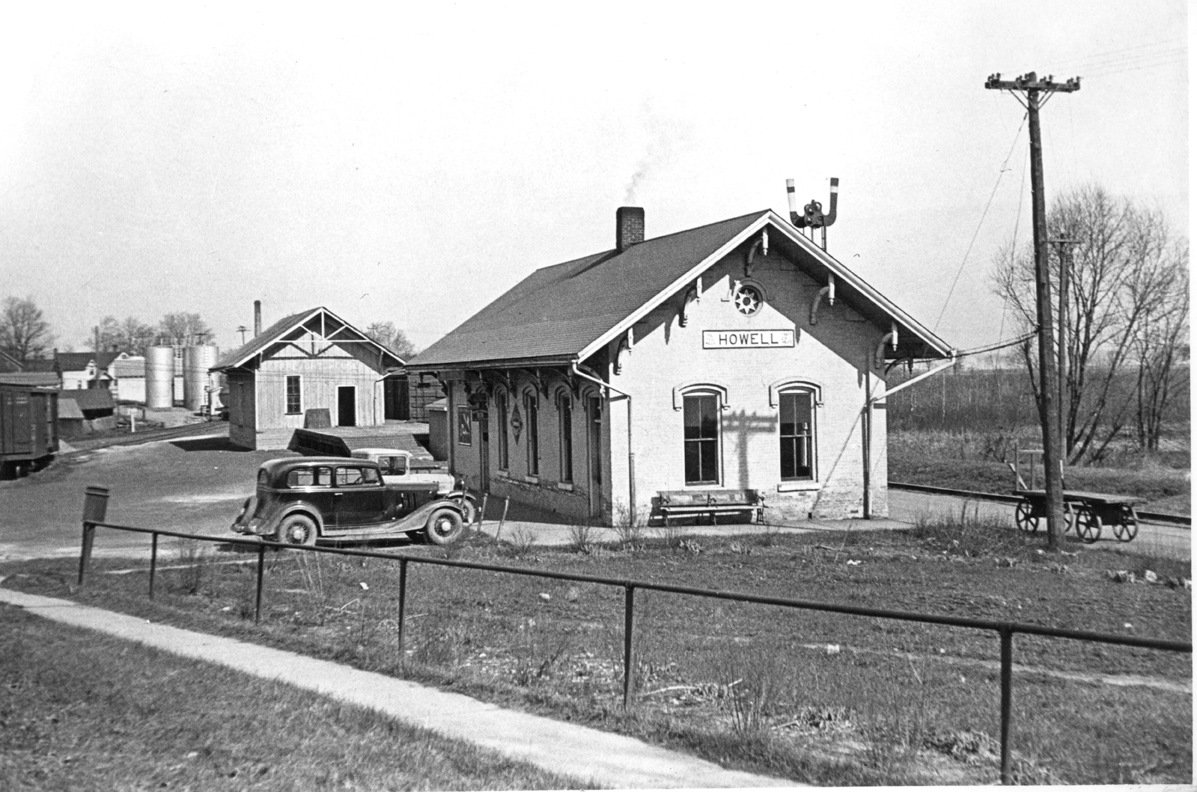 The
Ann Arbor served communities along a line beginning in Toledo, Ohio and
running northwest until it reached Frankfort and Elberta. Through its
extensive system of ferries the railroad established a water link from
Elberta to many ports in Wisconsin
and Michigan's Upper Peninsula. The Ann Arbor primarily served
Michigan communities by moving freight south to Toledo or westward
across Lake Michigan.
The
Ann Arbor served communities along a line beginning in Toledo, Ohio and
running northwest until it reached Frankfort and Elberta. Through its
extensive system of ferries the railroad established a water link from
Elberta to many ports in Wisconsin
and Michigan's Upper Peninsula. The Ann Arbor primarily served
Michigan communities by moving freight south to Toledo or westward
across Lake Michigan.
Because it was a freight line passenger service became a matter of secondary concern. This was not always the case. In 1913, 1.1 million passenger tickets were sold by the Ann Arbor. Whether because of poor service or due to the competition from automobiles, or both, the Annie's passenger business rapidly declined. In the years after World War II less than 50,000 passengers annually rode the rails. By this time it was common to put passenger trains on a siding to allow the more profitable freight trains to keep to their schedule.
Much of this freight consisted of "through traffic," freight cars that originated somewhere to the west of Lake Michigan and were bound for railroad stations somewhere to the east of Toledo. Through traffic was essential to the line's health because the railroad served none of the state's major industrial centers. As H.A. McBride marveled in 1953, "It would therefore seem fairly difficult to have laboriously put together a railroad clear across the state without touching a single jackpot [a major industrial community] but that is about what happened to the Ann Arbor. It winds northwestward 292 miles from Toledo to Frankfurt and succeeds in avoiding every big city all along the way by at least 15 or 20 miles – quite a feat!" The Ann Arbor Railroad lived, and died, by the perceived need of shippers to avoid the massive freight yards of Chicago.
Maintaining the Railroad
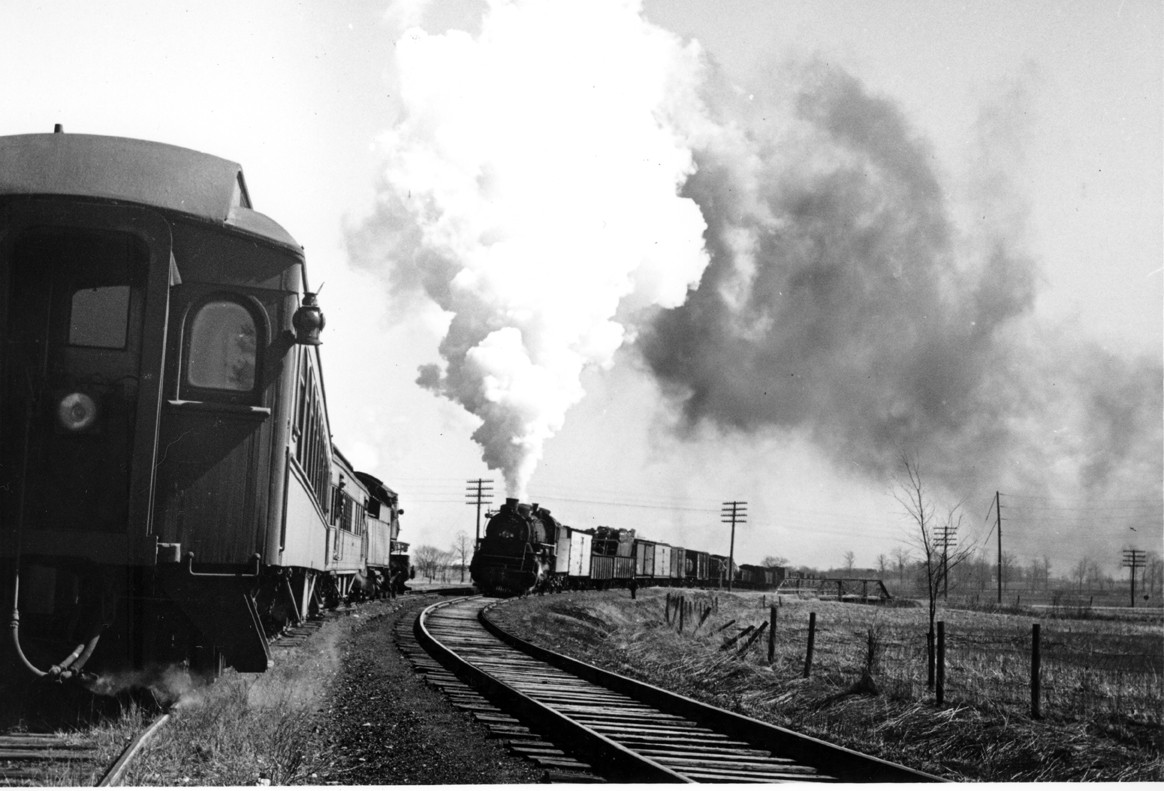 The
Ann Arbor was originally built as inexpensively as possible; "on wind,"
in the words of the James Ashley, the line's president. As a result, in
1890 the firm's chief engineer, Henry Riggs, described it as a
"jerkwater line." Oddly, the bankruptcy
of the line in 1893 led to major improvements, as the receivers
sought to make the property they controlled more marketable. By 1900 the
railroad was in far better physical shape and was capable of serving a
first-rate, steam-powered railroad.
The
Ann Arbor was originally built as inexpensively as possible; "on wind,"
in the words of the James Ashley, the line's president. As a result, in
1890 the firm's chief engineer, Henry Riggs, described it as a
"jerkwater line." Oddly, the bankruptcy
of the line in 1893 led to major improvements, as the receivers
sought to make the property they controlled more marketable. By 1900 the
railroad was in far better physical shape and was capable of serving a
first-rate, steam-powered railroad.
The railroads daily operations were often routine activities. Many of these activities involved inspection and preventative maintenance. Engines, rolling stock, track, and the ferries, were all regularly inspected. Small repairs often avoided larger problems and, perhaps, major accidents. Rules and regulations also played an important role in the safe operation of the line. In some cases the rules were self-created. Other regulations were imposed by government.
For many people, the end of the steam engine marked the end of the great era of railroading. The economic advantages of diesel engines were, decisive. Diesel engines could pull larger trains, did not need the elaborate infra-structure of water stations required for steam power, and could be run by smaller crews. In 1950, the Ann Arbor replaced its steam engines with diesel powered units.
Decline and Restructuring
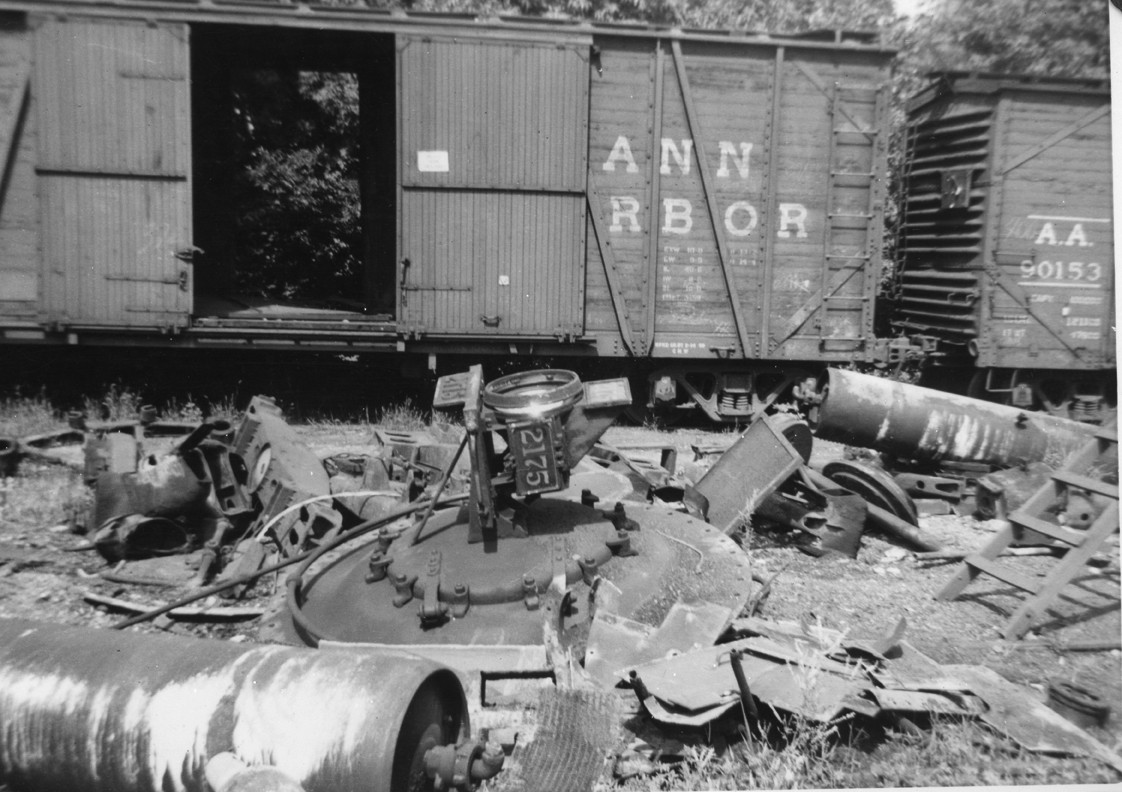 After 1945
railroads became increasingly unprofitable. "We've got more folks in
the crew than we generally carry on the train," said an Ann Arbor
conductor. On July 19, 1950 the Ann Arbor's regularly scheduled
passenger trains completed their last runs.
Two decades later, freight traffic also declined. Fewer and fewer
shippers saw the need to bypass Chicago, decreasing the line's all
important through traffic. In 1973 the railroad declared bankruptcy. .
Despite various efforts to save the entire
line, in 1982 the ferries were permanently docked and operations
ceased on all track north of the city of Ann Arbor. Today the Ann Arbor
Railroad hauls freight between Ann Arbor and Toledo. Much of the
northern track is operated by the Tuscola and
Saginaw Bay Railroad.
After 1945
railroads became increasingly unprofitable. "We've got more folks in
the crew than we generally carry on the train," said an Ann Arbor
conductor. On July 19, 1950 the Ann Arbor's regularly scheduled
passenger trains completed their last runs.
Two decades later, freight traffic also declined. Fewer and fewer
shippers saw the need to bypass Chicago, decreasing the line's all
important through traffic. In 1973 the railroad declared bankruptcy. .
Despite various efforts to save the entire
line, in 1982 the ferries were permanently docked and operations
ceased on all track north of the city of Ann Arbor. Today the Ann Arbor
Railroad hauls freight between Ann Arbor and Toledo. Much of the
northern track is operated by the Tuscola and
Saginaw Bay Railroad.
Rail to Water
 When ferry service first began across Lake Michigan, freight was unloaded from rail cars and placed on the ferry, to be reloaded onto trains across the water. This slow, expensive process was replaced by ferries capable
of carrying fully loaded rail cars. The Ann Arbor pioneered in this daring experiment and although it success was copied by other railroads, its ferries kept the line profitable.
When ferry service first began across Lake Michigan, freight was unloaded from rail cars and placed on the ferry, to be reloaded onto trains across the water. This slow, expensive process was replaced by ferries capable
of carrying fully loaded rail cars. The Ann Arbor pioneered in this daring experiment and although it success was copied by other railroads, its ferries kept the line profitable. To maintain its extensive network of water transportation the Ann Arbor required a large number of ferry boats. Between 1892 and 1925 the Ann Arbor built eight ferries which eventually utilized six ports. In the 1950s the Ann Arbor considered constructing new ferries, but the predicted cost led the company to rebuild existing vessels. In 1973 the Ann Arbor defaulted on the loan obtained to reconstruct a ferry, forcing the line into bankruptcy. For several years the State of Michigan kept the ferries running, but in 1982 all ferry operations from the Ann Arbor's home port of Elberta ceased.
Ann Arbor #1
 Launched in September 1892, the wooden hulled #1 could carry 24 railroad cars at a speed of 14 knots. Shippers were hesitant to trust the ferry. The railroad obtained freight for the ship's first voyage by strong-arming the coal company
from which the Ann Arbor bought its fuel to ship a few cars loaded with coal. Shippers' confidence in the boat was not improved when the #1 ran aground on its maiden voyage. Despite this difficult beginning the ship proved a financial
success and led to a fleet of similar vessels on Lake Michigan. On March 8, 1910 fire burned the #1 to the water line. The hull was eventually converted into a sand scow.
Launched in September 1892, the wooden hulled #1 could carry 24 railroad cars at a speed of 14 knots. Shippers were hesitant to trust the ferry. The railroad obtained freight for the ship's first voyage by strong-arming the coal company
from which the Ann Arbor bought its fuel to ship a few cars loaded with coal. Shippers' confidence in the boat was not improved when the #1 ran aground on its maiden voyage. Despite this difficult beginning the ship proved a financial
success and led to a fleet of similar vessels on Lake Michigan. On March 8, 1910 fire burned the #1 to the water line. The hull was eventually converted into a sand scow.
Ann Arbor #2
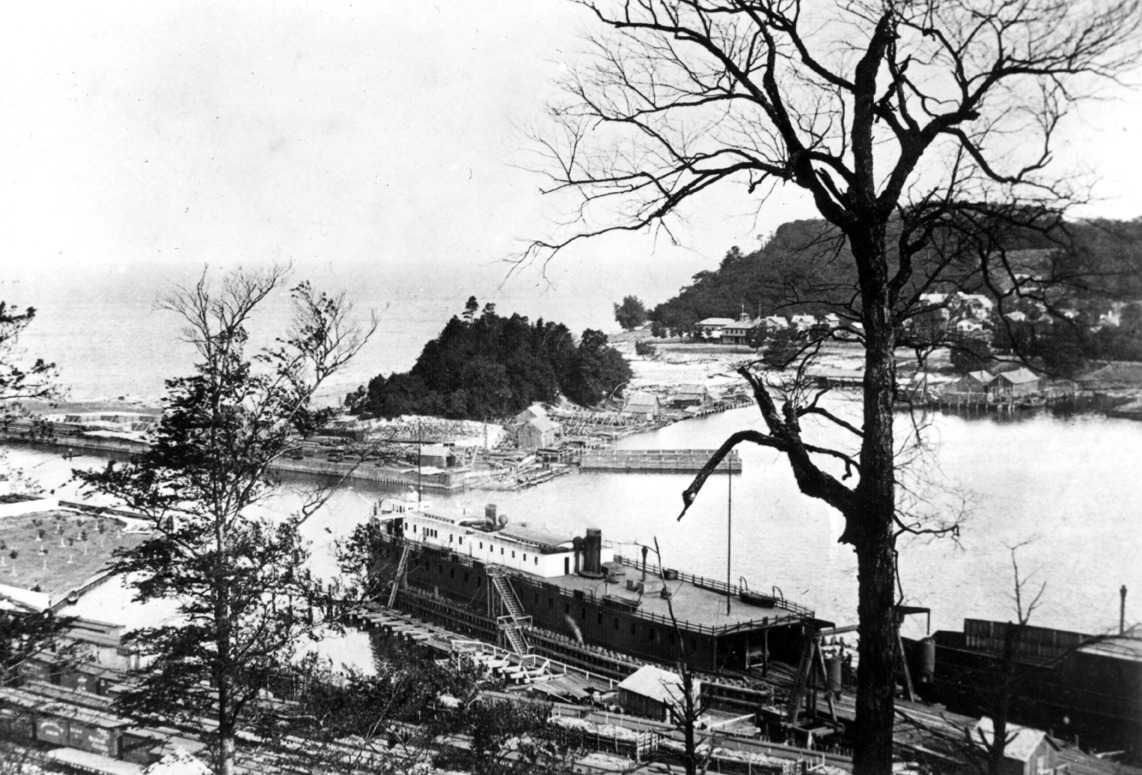 Launched in December 1892, the wooden #2 was very similar in design to the #1. The vessel's wooden hull quickly became obsolete, dooming the ship to a relatively short life. In the fall of 1912 the vessel made its
last run, replaced by the newly launched #5. In December 1913 the #2 was sold, cut down, and converted into a sand-sucking barge. In the ship's short history its most harrowing experience occurred in January 1897 when
it was trapped in ice just south of Frankfort for 23 days.
Launched in December 1892, the wooden #2 was very similar in design to the #1. The vessel's wooden hull quickly became obsolete, dooming the ship to a relatively short life. In the fall of 1912 the vessel made its
last run, replaced by the newly launched #5. In December 1913 the #2 was sold, cut down, and converted into a sand-sucking barge. In the ship's short history its most harrowing experience occurred in January 1897 when
it was trapped in ice just south of Frankfort for 23 days.
Ann Arbor #3
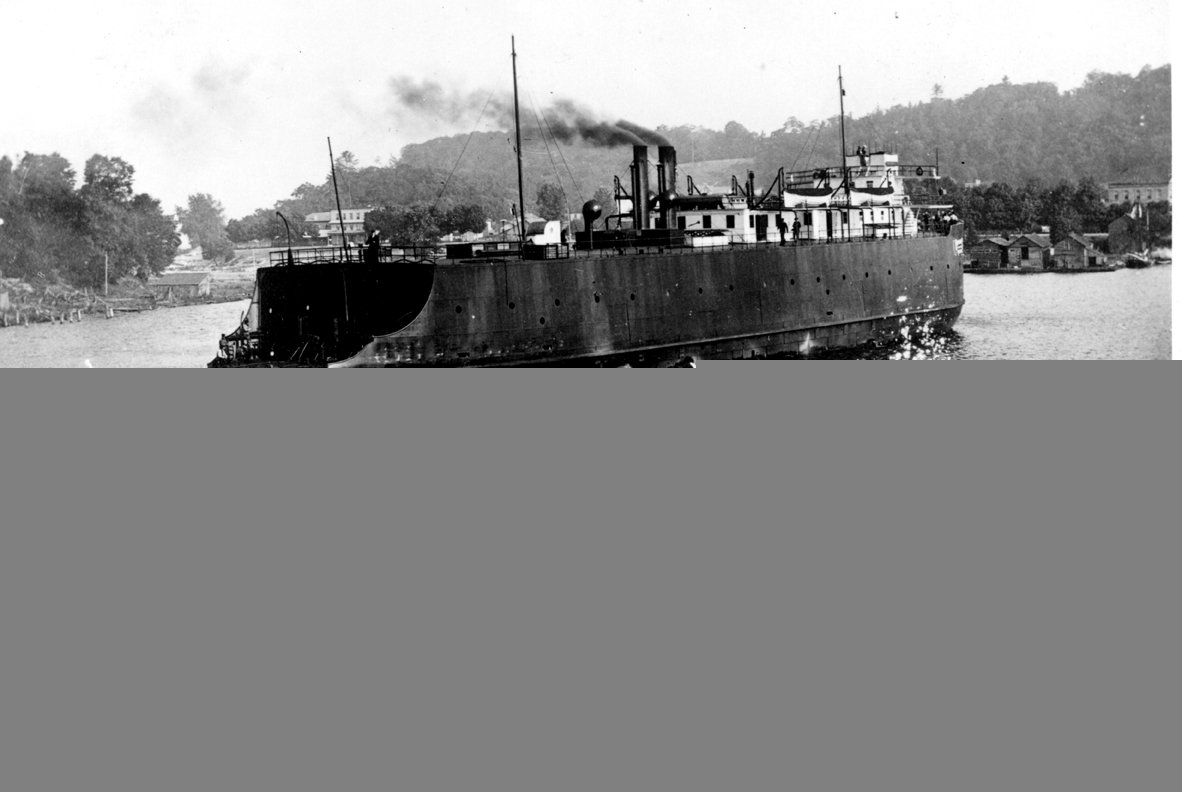 The first steel-hulled car ferry built for the Ann Arbor, the vessel was launched in 1898. The #3 could carry 22 railroad cars and also had a hold designed to carry grain. In 1923 the ship was lengthened by 48 feet, allowing
it to carry 24 longer railway cars. The #3 was the safest of the Ann Arbor's ferries. After a long career, the aging vessel was laid up in 1960. In 1962 the ship was sold and cut down to serve as a barge. However, because the railroad
tracks were not removed, in 1965 and again in 1968 the barge was used to transport railroad cars across the Straits of Mackinac.
The first steel-hulled car ferry built for the Ann Arbor, the vessel was launched in 1898. The #3 could carry 22 railroad cars and also had a hold designed to carry grain. In 1923 the ship was lengthened by 48 feet, allowing
it to carry 24 longer railway cars. The #3 was the safest of the Ann Arbor's ferries. After a long career, the aging vessel was laid up in 1960. In 1962 the ship was sold and cut down to serve as a barge. However, because the railroad
tracks were not removed, in 1965 and again in 1968 the barge was used to transport railroad cars across the Straits of Mackinac.
Ann Arbor #4
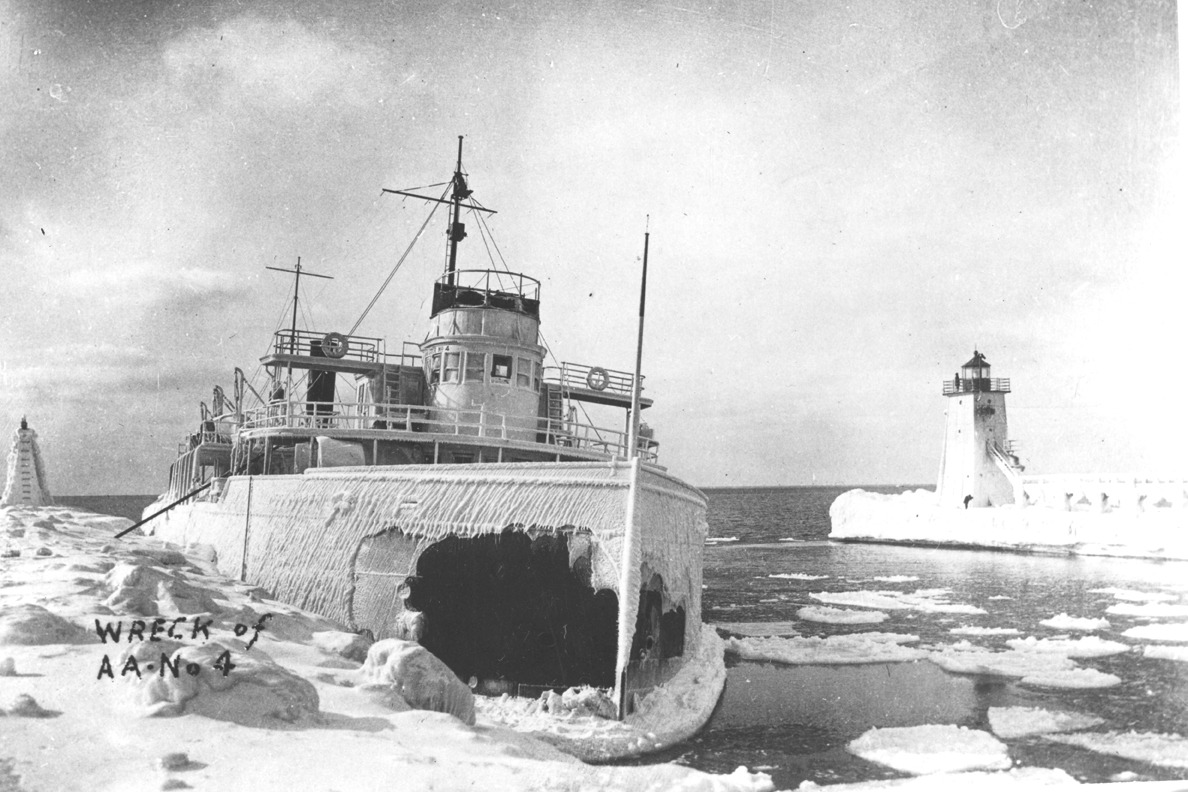 The steel-hulled #4 had more than its share of troubles. In May 1909 the crew incorrectly loaded cars carrying iron ore, causing the vessel to capsize. The ship was eventually put back into service. In February 1923 the ship
was caught in a huge gale. One of the rail cars broke loose and smashed through the seagate as it fell into the lake. Taking water, the ship miraculously made its way back to Frankfort, sinking alongside the south breakwall of the harbor. The ship
was sold in 1937 to the State of Michigan, which renamed the vessel the City of Cheboygan and used it as an auto ferry at the Straits of Mackinac.
The steel-hulled #4 had more than its share of troubles. In May 1909 the crew incorrectly loaded cars carrying iron ore, causing the vessel to capsize. The ship was eventually put back into service. In February 1923 the ship
was caught in a huge gale. One of the rail cars broke loose and smashed through the seagate as it fell into the lake. Taking water, the ship miraculously made its way back to Frankfort, sinking alongside the south breakwall of the harbor. The ship
was sold in 1937 to the State of Michigan, which renamed the vessel the City of Cheboygan and used it as an auto ferry at the Straits of Mackinac.
Ann Arbor #5
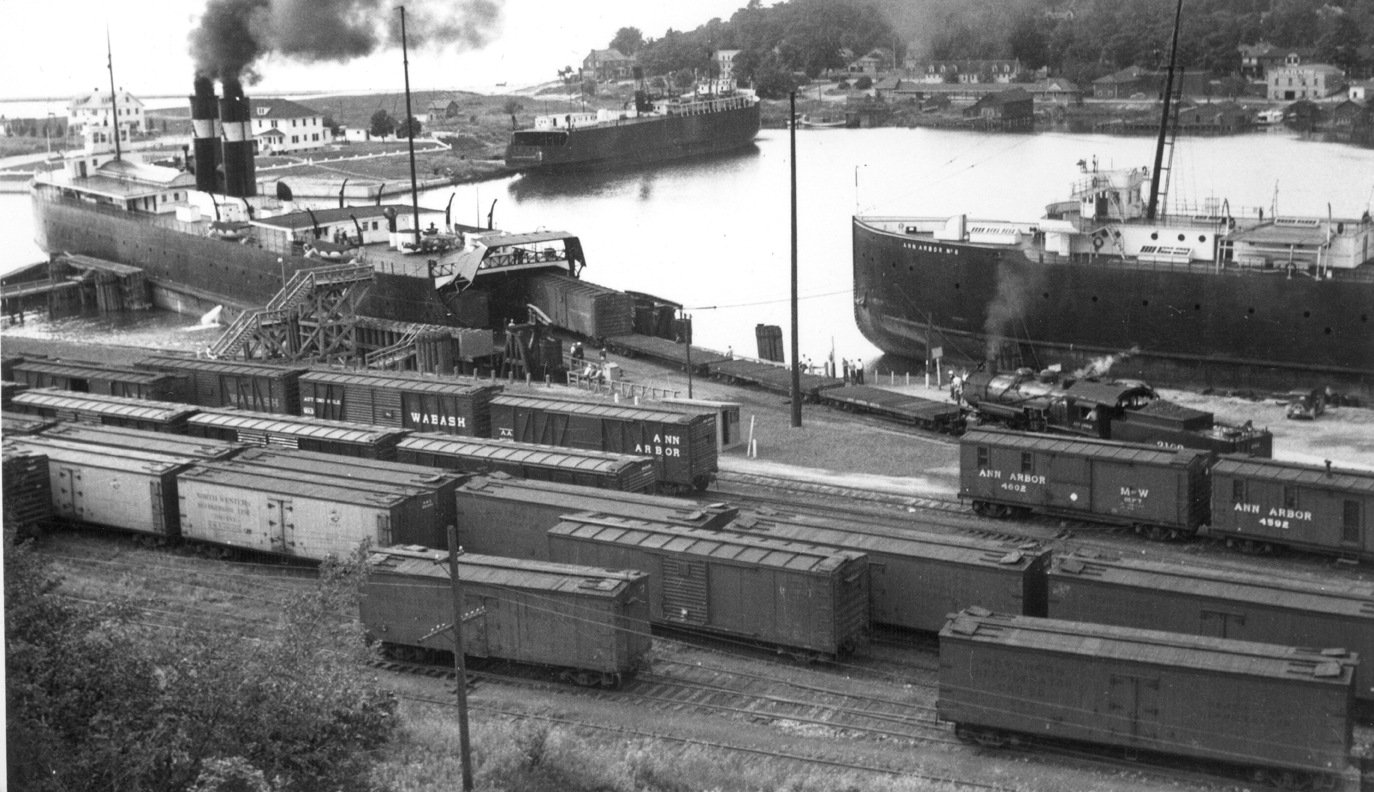 At the time of its launch in November 1910, the #5 was the largest ferry on the lakes. It was also the first launched with a seagate; a safety device designed to keep water from flooding in the low stern. With a capacity of 30 railroad
cars and engines capable of generating 3,000 horsepower, the #5 was frequently called upon to clear ports and channels. The ship's career was uneventful. After more than fifty years of service, in 1965 the ship was retired. Between
1967 and 1969 the ship's hull became the temporary breakwater at South Haven. In 1970 the vessel was sold for scrap.
At the time of its launch in November 1910, the #5 was the largest ferry on the lakes. It was also the first launched with a seagate; a safety device designed to keep water from flooding in the low stern. With a capacity of 30 railroad
cars and engines capable of generating 3,000 horsepower, the #5 was frequently called upon to clear ports and channels. The ship's career was uneventful. After more than fifty years of service, in 1965 the ship was retired. Between
1967 and 1969 the ship's hull became the temporary breakwater at South Haven. In 1970 the vessel was sold for scrap.
Ann Arbor #6/Arthur K. Atkinson
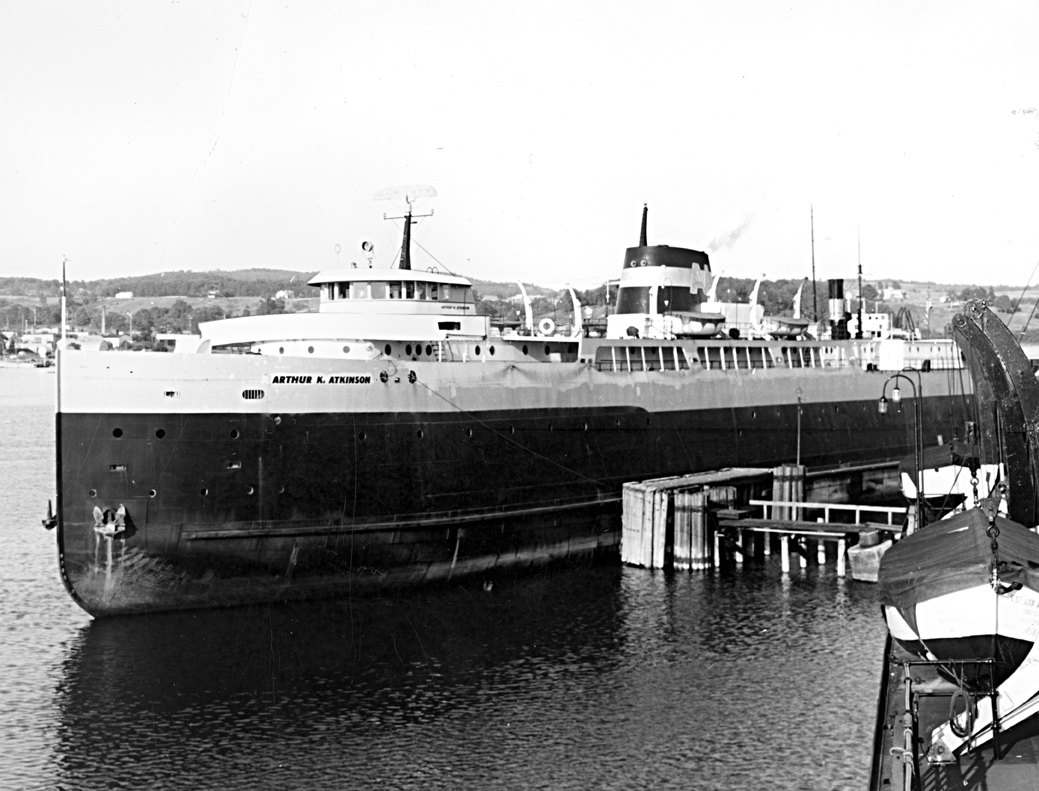 Originally ordered for service on Lake Erie, the #6 was diverted to Lake Michigan and the service of the Ann Arbor. In 1959 the ship was dramatically rebuilt. Steam engines gave way to diesel power and the hull was lengthened from 338
to 372 feet, allowing the vessel to carry 30 railroad cars. The ship re-entered service with a new name, Arthur K. Atkinson, in honor of the then president of the Ann Arbor's parent firm. Between 1973 and 1979 the Atkinson was
laid up with a broken crankshaft. Eventually put back into service in 1980, the ship was laid up in 1982. It has passed through the hands of several owners since then, but has never been put back in service.
Originally ordered for service on Lake Erie, the #6 was diverted to Lake Michigan and the service of the Ann Arbor. In 1959 the ship was dramatically rebuilt. Steam engines gave way to diesel power and the hull was lengthened from 338
to 372 feet, allowing the vessel to carry 30 railroad cars. The ship re-entered service with a new name, Arthur K. Atkinson, in honor of the then president of the Ann Arbor's parent firm. Between 1973 and 1979 the Atkinson was
laid up with a broken crankshaft. Eventually put back into service in 1980, the ship was laid up in 1982. It has passed through the hands of several owners since then, but has never been put back in service.
Ann Arbor #7/Viking
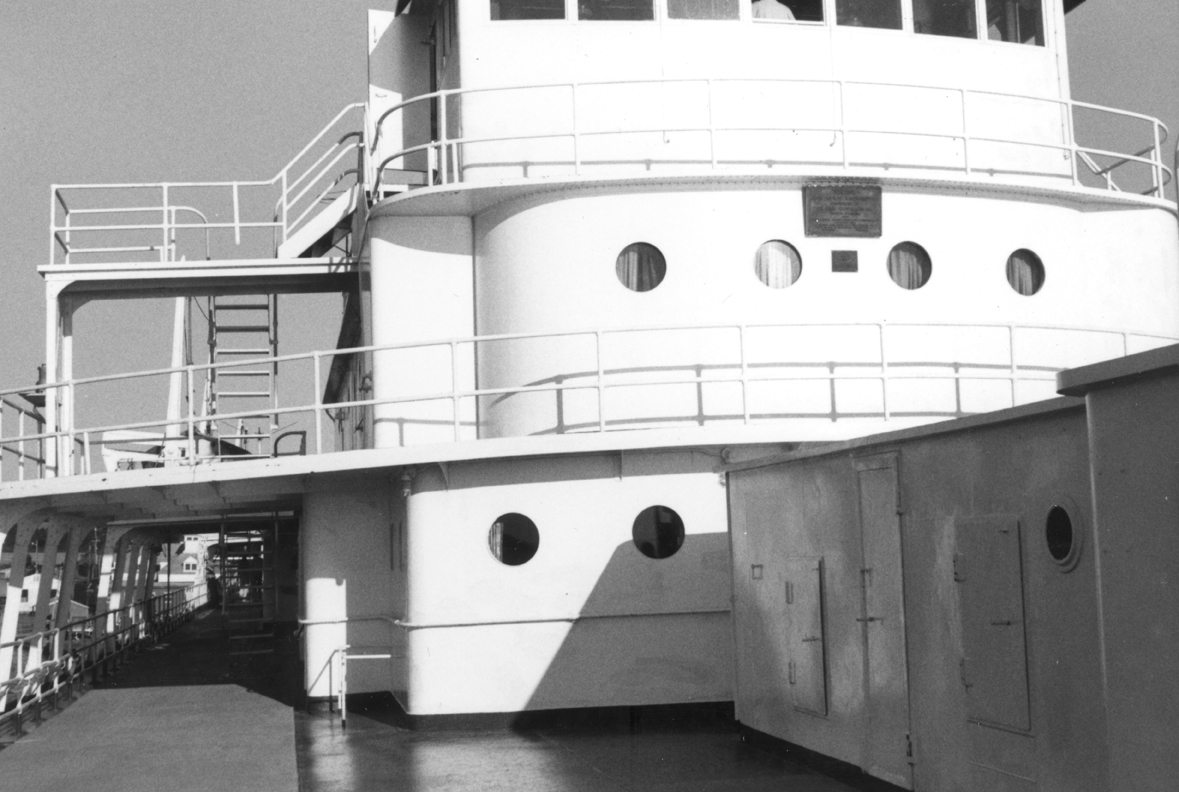 Built in 1925 as the #7, the ship's sailing life was uneventful. In 1965 the vessel was rebuilt, with four diesel engines and a bow thruster replacing the ship's original coal-fired steam engines. The new engines added five miles per
hour to the ship's speed, making the Viking the fastest ferry on the lakes. The Viking's lake service ended in 1982, after which the vessel passed through the control of several owners but without being put back
into service.
Built in 1925 as the #7, the ship's sailing life was uneventful. In 1965 the vessel was rebuilt, with four diesel engines and a bow thruster replacing the ship's original coal-fired steam engines. The new engines added five miles per
hour to the ship's speed, making the Viking the fastest ferry on the lakes. The Viking's lake service ended in 1982, after which the vessel passed through the control of several owners but without being put back
into service.
Wabash/City of Green Bay
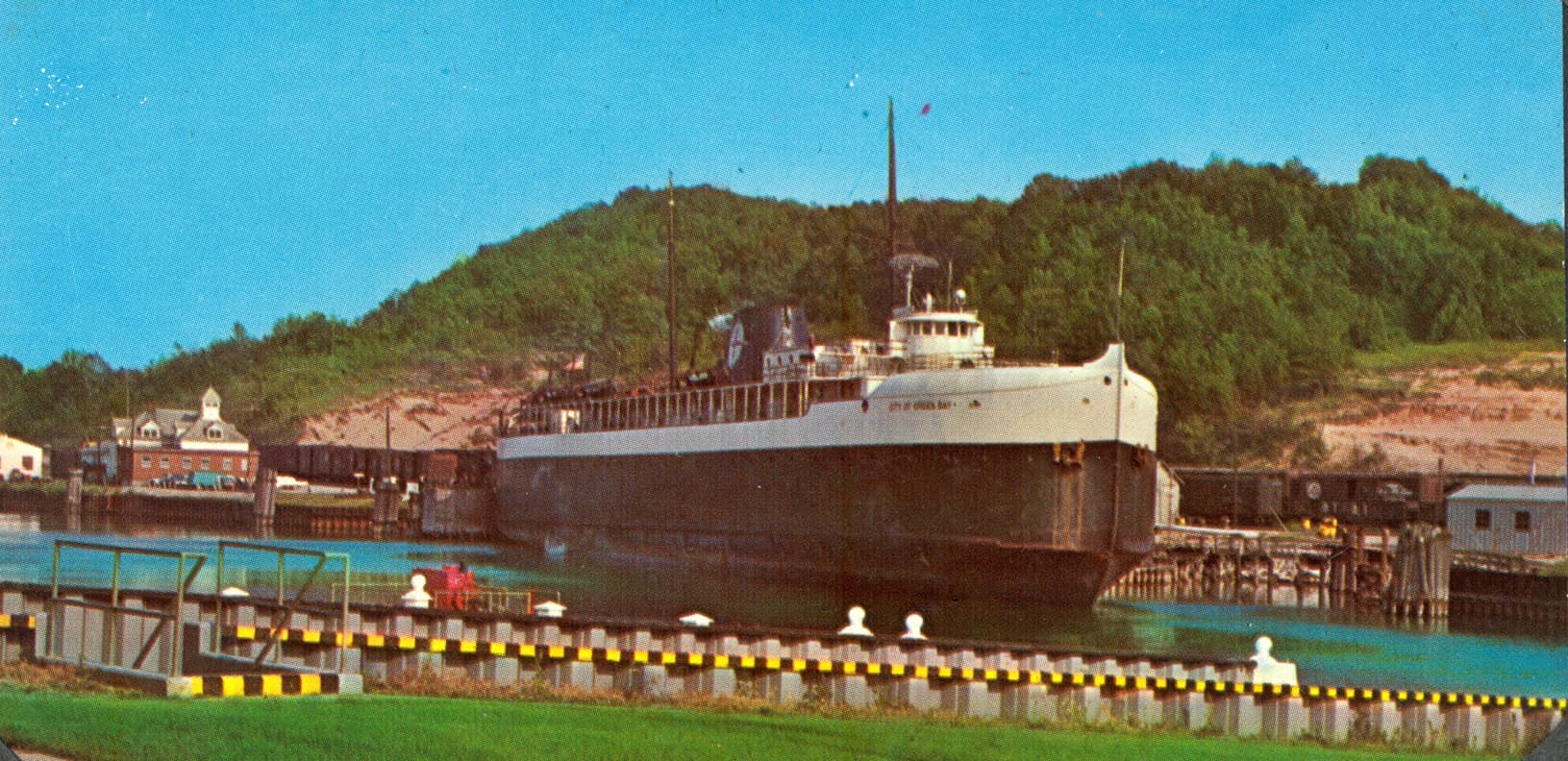 Launched in 1927, the Wabash was the last vessel built for the Ann Arbor. It was the only one to be put into service with a name rather than a number. Controlling interest in the Ann Arbor had been obtained by the Wabash Railroad in
1925. In 1929 and 1959 the ship sailed into enormous storms which threatened to sink the vessel but each time it managed to reach port. Minimally rebuilt and renamed the City of Green Bay, the vessel operated until 1972. In 1974 the
ship was sold for scrap.
Launched in 1927, the Wabash was the last vessel built for the Ann Arbor. It was the only one to be put into service with a name rather than a number. Controlling interest in the Ann Arbor had been obtained by the Wabash Railroad in
1925. In 1929 and 1959 the ship sailed into enormous storms which threatened to sink the vessel but each time it managed to reach port. Minimally rebuilt and renamed the City of Green Bay, the vessel operated until 1972. In 1974 the
ship was sold for scrap.
City of Milwaukee
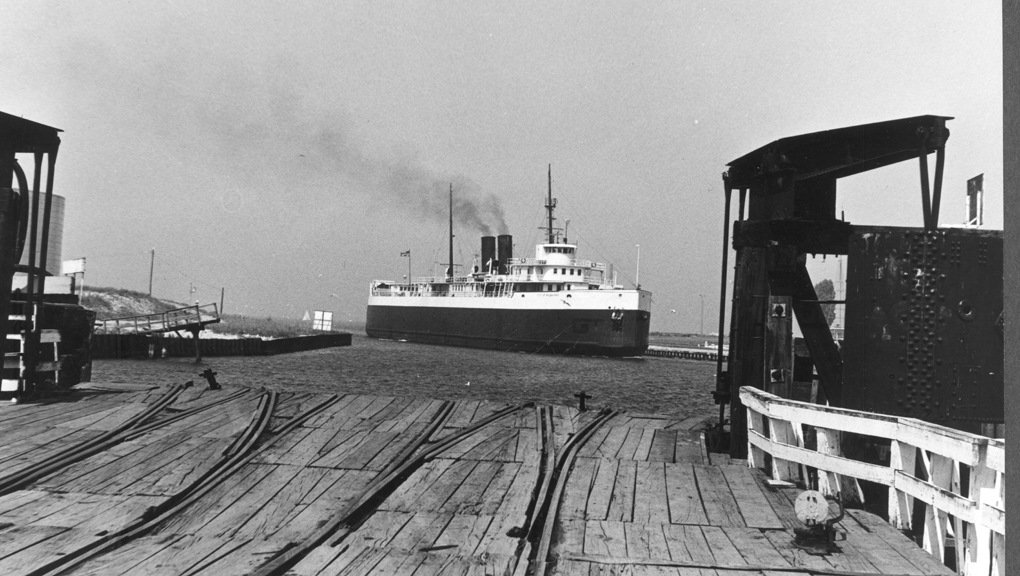 Built in 1931 for the Grand Trunk Railway, the City of Milwaukee served that railroad until 1978, when the Grand Trunk discontinued its Lake Michigan ferry service. The Ann Arbor immediately acquired the boat as a replacement for the
laid-up
Atkinson and put the Milwaukee into service. The Milwaukee experienced a series of mechanical problems, including losing power mid-lake and having to be towed to port. In 1980, when the
Atkinson was put back in service, the Milwaukee was laid up. Today the ship is a museum vessel in Manistee, Michigan.
Built in 1931 for the Grand Trunk Railway, the City of Milwaukee served that railroad until 1978, when the Grand Trunk discontinued its Lake Michigan ferry service. The Ann Arbor immediately acquired the boat as a replacement for the
laid-up
Atkinson and put the Milwaukee into service. The Milwaukee experienced a series of mechanical problems, including losing power mid-lake and having to be towed to port. In 1980, when the
Atkinson was put back in service, the Milwaukee was laid up. Today the ship is a museum vessel in Manistee, Michigan.